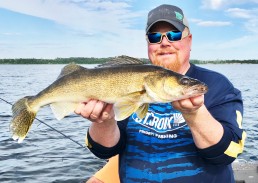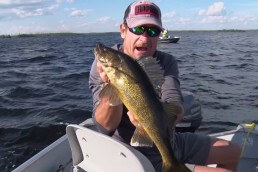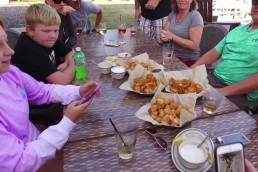The Bug Hatch is Rigged for Walleyes
SHARE THIS POST
Summer always comes, regardless of what else is going on in the world. Fishing is all about patterns and interrelationships between predators and prey, which keeps changing through the seasons. When the spawn ends the bug hatch is rigged for walleyes.
The Spawn
Other than members of the sunfish family, most predators and prey have finished spawning by early June across the Upper Midwest.
Largemouth bass, smallmouth bass, crappies and sunfish are some of the last fish to spawn in the spring. The sunfish family all spawn when surface water temperatures reach the mid 60s or warmer.
The peak spring walleye bite usually happens when surface water temperatures break the 60-degree mark. The males bite early in the season, but by late May the larger female walleyes are fully recovered and ready to feed.
Measuring surface water temperatures the first thing in the morning on my Humminbird Helix 12 is a key. I always have water temperature on my sonar readouts, regardless of the time of year. It helps to track what temperature the lakes are able to hold overnight, not the spikes in temperature that happen during the day.
The Insect Hatch
Many walleyes move off shoreline structure when the minnows finish spawning (primarily shiners) and the insect hatches begin in the mud basin.
Insect hatches occur out of mud bottom, with most of the mud in the basin. There are also areas of mud in shallow water, which are often less obvious.
Walleyes begin to scatter after the minnows finish spawning along the shoreline. Some walleyes look for larger prey like perch and crayfish in the weeds, while other walleyes head for mid-lake structures to feed along the edges of the mud basin.
I like to fish a jig and minnow whenever I can. Eventually, the spottail shiners finish spawning and leave the shoreline. Spottail shiners are a spring thing in the bait stores and only last as long as bait trappers can catch them.
The Setup
When walleyes start feeding in deep water, most anglers switch to a live bait rig with leeches, nightcrawlers or larger minnows like chubs or golden shiners.
Live bait can be rigged many different ways, but it is basically a hook, leader and swivel with some kind of slip sinker.
I like a longer rod with a sensitive tip, so I can feel the bites better. The St. Croix Legend Elite 7- to 7 1/2-foot ML is perfect for livebait rigs. I like rods with a fast action and a good backbone, so I can play larger walleyes on light line with small hooks, and still keep control of the fish.
Reels with slightly larger spools for livebait rigging, help to reduce line twist with the larger diameter spool. I usually fill reels with green 10-pound-test Sunline SX1 with a mono backing.
The type and weight sinker depends on the depth and the bottom type. I use a small bullet sinker when I fish shallow, keep the speed up, and regulate the amount of line I let out to try avoid dragging the sinker on the bottom and picking up slime off the bottom.
Are you enjoying this post?
You can be among the first to get the latest info on where to go, what to use and how to use it!
Equipment
If I am fishing deep, especially if there are some rocks, I like the Northland Rock Runner, low-profile slip sinker. Using a good quality ball bearing swivel with the solid rings instead of split rings, so I don’t put nicks in the line.
I use Sunline FC Sniper fluorocarbon leaders, usually 8-pound test, in varying lengths. I go with lighter leaders in some situations when walleyes are finicky or when I am fishing super-clear water.
A #4 or #6 Gamakatsu Salmon style hook because larger hooks tend to drag on the bottom and catch more slime. I like red or bronze Gamakatsu hooks, depending on the conditions. I often add a red glass bead in clear water or a green chartreuse glow bead in stained or dirty water.
Longer leaders require a longer-handled net. Frabill makes extending handles on some of their Conservation Series Nets, so anglers can reach walleyes on the end of super-long leaders.
Frabill Bait Stations come in several sizes, so anglers can have an insulated aerated container for larger minnows, and smaller baits like leeches in their own containers.
Electronics
I use livebait rigs to work through an area holding scattered walleyes. The MinnKota Terrova can run me through the same trolling paths or, with a couple of keystrokes, I can move over ten feet in either direction and repeat a similar, parallel path.
If I see a concentration of fish, I can hit the Spot Lock feature on my MinnKota and hold upwind of the fish. I will make a few casts with a Northland Fireball Jig and leech, or I can use a short leader snell and a larger minnow to cast to the walleyes.
I use the side imaging feature on my Helix 12 while I am fishing, so I can see and mark fish out to the side of the boat. Anglers can look at their LakeMaster lake maps and read them just like a road map.
Conclusion
Fish have to swim to their new locations, so anglers should be able to see where the fish have been and where the fish are likely headed, so they can look at the natural pathways leading the fish to the new areas.
Walleyes are opportunistic and rarely in a hurry. They usually feed their way between locations. If they run into a good feeding area on the way, they don’t have a schedule and are free to stop. Walleyes don’t usually have to be at any specific location by any specific time.
Early in the summer, oxygen levels are good at all depths in the lakes. Walleyes and other species can be as deep or as shallow as they want to be. Their biggest limiting factor is food, so keep that in mind as you search for active fish.
Good luck fishing and follow our adventures on social media. Fish On!
Become a MidWest Outdoors Insider here!
MWO
SHARE THIS POST
Did you enjoy this post?
You can be among the first to get the latest info on where to go, what to use and how to use it!
Brian 'Bro' Brosdahl
Outdoor communicator Brian “Bro” Brosdahl lives in northern Minnesota. He is a walleye guide in the Cass Lake, Leech Lake and Lake Winnibigoshish areas. He is sponsored by Northland Fishing Tackle, Frabill/Plano, Aqua-Vu, Humminbird/Minn Kota, St. Croix Rods, Ranger Boats, and Evinrude. Guide inquiries: brosguideservice.com. Follow on social media.



